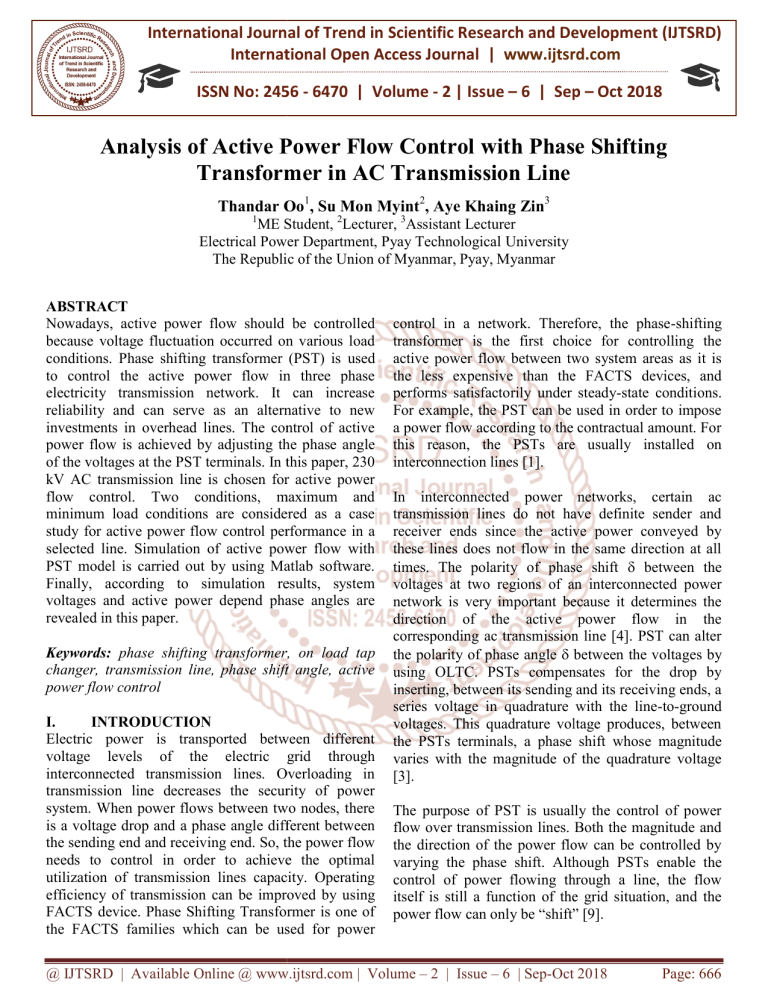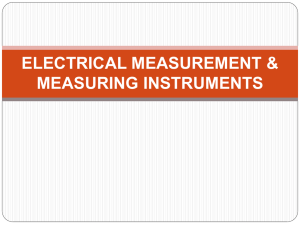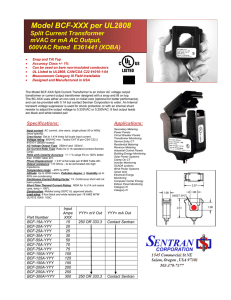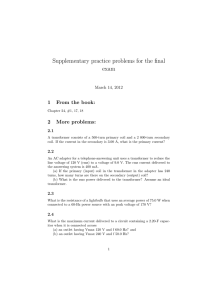
International Journal of Trend in Scientific Research and Development (IJTSRD)
International Open Access Journal | www.ijtsrd.com
ISSN No: 2456 - 6470 | Volume - 2 | Issue – 6 | Sep – Oct 2018
Analysis of Active Power Flow Control with Phase Shifting
Transformer in AC Transmission Line
Thandar Oo1, Su Mon Myint2, Aye Khaing Zin3
1
ME Student, 2Lecturer, 3Assistant Lecturer
Electrical Power Department, Pyay Technological University
The Republic of the Union of Myanmar
Myanmar, Pyay, Myanmar
ABSTRACT
Nowadays, active power flow should be controlled
because voltage fluctuation occurred on various load
conditions. Phase shifting transformer (PST) is used
to control the active power flow in three phase
electricity transmission network. It can increase
reliability and can serve as an alternative to new
investments in overhead lines. The control of active
power flow is achieved by adjusting the phase ang
angle
of the voltages at the PST terminals. In this paper, 230
kV AC transmission line is chosen for active power
flow control. Two conditions, maximum and
minimum load conditions are considered as a case
study for active power flow control performance in a
selected
elected line. Simulation of active power flow with
PST model is carried out by using Matlab software.
Finally, according to simulation results, system
voltages and active power depend phase angles are
revealed in this paper.
Keywords: phase shifting transformer,
former, on load tap
changer, transmission line, phase shift angle, active
power flow control
I.
INTRODUCTION
Electric power is transported between different
voltage levels of the electric grid through
interconnected transmission lines. Overloading in
transmission line decreases the security of power
system. When power flows between two nodes, there
is a voltage drop
rop and a phase angle different between
the sending end and receiving end. So, the power flow
needs to control in order to achieve the optimal
utilization of transmission lines capacity. Operating
efficiency of transmission can be improved by using
FACTS device.
evice. Phase Shifting Transformer is one of
the FACTS families which can be used for power
control in a network. Therefore, the phase-shifting
phase
transformer is the first choice for controlling the
active power flow between two system areas as it is
the less
ss expensive than the FACTS devices, and
performs satisfactorily under steady-state
steady
conditions.
For example, the PST can be used in order to impose
a power flow according to the contractual amount. For
this reason, the PSTs are usually installed on
interconnection lines [1].
In interconnected power networks, certain ac
transmission lines do not have definite sender and
receiver ends since the active power conveyed by
these lines does not flow in the same direction at all
times. The polarity of phase shift between the
voltages at two regions of an interconnected power
network is very important because it determines the
direction of the active power flow in the
corresponding ac transmission line [4]. PST can alter
the polarity of phase angle between the voltages
v
by
using OLTC. PSTs compensates for the drop by
inserting, between its sending and its receiving ends, a
series voltage in quadrature with the line-to-ground
line
voltages. This quadrature voltage produces, between
the PSTs terminals, a phase shift whose
whos magnitude
varies with the magnitude of the quadrature voltage
[3].
The purpose of PST is usually the control of power
flow over transmission lines. Both the magnitude and
the direction of the power flow can be controlled by
varying the phase shift. Although
Alth
PSTs enable the
control of power flowing through a line, the flow
itself is still a function of the grid situation, and the
power flow can only be “shift” [9].
@ IJTSRD | Available Online @ www.ijtsrd.com | Volume – 2 | Issue – 6 | Sep-Oct
Oct 2018
Page: 666
International Journal of Trend in Scientific Research and Development (IJTSRD) ISSN: 2456-6470
2456
II.
POWER FLOW CONTROL
A. Controlling the power flow through a
transmission line
A simplified relation between active power
transported over a transmission line between sending
and receiving nodes and the complex voltages at both
nodes is:
PLine
V V
S
sin( )
R
X Line
L2
L3
S2
B. Phase Shifting Transformer
The PST is installed as a series reactance with a phase
shift in transmission line. The power flow through the
line is increased by adding an angle to the existing
angle.. The phase shift is controllable within certain
limits. The PST is a mechanically switched
witched device
which inserts a transformed, variable (using a tap
changer) line voltage in series with the phase voltage.
Figure 1(a) depicts this for direct symmetrical phase
phaseshifting transformer and Figure 1(b) depicts its phasor
diagram.
sin( )
S3
(1)
Where sending node VS and receiving node VR, the
phase angle between
en these voltages and XLine the
impedance. The active power is proportional to the
voltages on the sending and the receiving ends and the
phase angle between both ends; it is also inversely
proportional to the line reactance. Therefore, the
power flow through
ugh the line can be controlled by
altering the voltage at a node, the impedance between
nodes and the angle between terminal voltages. The
line flow can also be altered by changing the line
impedance. This can be done by inserting variable
series impedance.. Then, the active power flow can
also be control by altering the phase angle between
sending and receiving ends voltage with a series
injected voltage in quadrature to the phase voltage.
V V
S
R
PLine X X
Line
S1
L1
(2)
PST
The state above can also be interpreted in another
way: the active power is proportional to the phase
angle between nodes. Altering the active power can
be done by altering the phase angles. Although phase
shifting
ifting transformers enable the control of power
flowing through a line, the flow itself is still a
function of the grid situation, and the power flow can
only be “shifted” [9].
(a)
V L1
DV 1
VS1
VS3
DV 3
VL2
V L3
V S2
DV 2
(b)
Figure.1. Direct symmetrical PST (a) Circuit diagram
and (b) Phasor diagram
III.
PRINCIPLES OF PHASE SHIFTING
TRANSFORMER
A. Basic Theory of Phase Shifting Transformer
The phase shifting transformer (PST) is a specialized
form of transformer used to control the active power
flow in three phase electricity transmission networks.
The term Phase Shifter is more generally used to
indicate a device which can inject a voltage with a
controllable phase angle and/or magnitude under nono
load (off-load) and load (on-load)
load) conditions.
conditi
Operation of a conventional phase-shifter
phase
is
characterized by:
High response time as a result of inertia of moving
parts, and
High level of maintenance due to mechanical
contacts and oil deterioration.
The main power circuitry of the phase shifting
transformer consists of Figure 2(a): the exciting
transformer that provides input voltage to the phase
shifter; the series transformer, that injects a
controllable voltage Vα in the transmission line; and
the converter or tap changer, which controls the
magnitude
gnitude and/or phase angle of the injected voltage.
A converter is used in case of a power electronic
based interface, and a tap changer is used in case of a
@ IJTSRD | Available Online @ www.ijtsrd.com | Volume – 2 | Issue – 6 | Sep-Oct
Oct 2018
Page: 667
International Journal of Trend in Scientific Research and Development (IJTSRD) ISSN: 2456-6470
2456
mechanical controlled phase shifting transformer.
The PST is a device that is used for power flow
control in order to relieve congestions in electrical
grids. Figure 2(a) shows a schematic diagram of a
phase shifter installed on a transmission line between
buses a and b. The sending and receiving ends of the
transmission line are represented by voltag
voltage phasors
VS and VR, and corresponding impedances ZS and ZR,
respectively.
ZS
Va
Vb
V ∠φ
Booster
Transformer
Converter
Or
OLTC
V S ∠S
Exciting
Transformer
ZR
VR ∠R
(a)
A'
A
Vb
V
φ
Va
C
C'
B'
B
(b)
(c)
Figure.2. Diagrams of a phase-shifting
shifting transformer:
(a) Schematic diagram; (b) Phasor diagram; (c) Phase
shift for advance [1]
B. Categories of Phase Shifting Transformer
PST’s come in many different forms. They can be
classified
fied by these characteristics:
Direct PST’s are based on one three-phase
three
core.
The phase shift is obtained by connecting the
windings in an appropriate manner.
Indirect PST’s are based on a construction with
two separate transformers; one variable tap exciter
to regulate the amplitude of the quadrature voltage
and one series transformer to inject the quadrature
voltage in the right phase.
Asymmetrical PST’s create an output voltage with
an altered
ltered phase angle and amplitude compared to
the input voltage.
Symmetrical PST’s create an output voltage with
an altered phase angle compared to the input
voltage, but with the same amplitude [7].
C. Delta-hexagonal
hexagonal
Type
Phase
Shifting
Transformer
In this paper, Delta-hexagonal
hexagonal type Phase Shifting
Transformer is applied for active power flow control.
This type of PST can be symmetrical with two tap
changers, as shown in Figure 3, or non-symmetrical
non
with only one tap changer. To maintain symmetry
when two
wo tap changers are used, the tap changers are
often interlocked such that they take alternating steps
from neutral to maintain no more than one step off of
symmetry.
Depending on the magnitude and phase angle of the
injected voltage Vα, the magnitude and/or phase
phase-angle
of the system voltage Vb is varied Figure 2(b). With a
flexible phase shifting transformer,
ransformer, the control range
achieved is a circle with centre in the tip of the phasor
Va and radius equal to the amplitude of V α. The output
voltage of the phase shifting transformer is controlled
by varying the amplitude and angle of the phasor V α,
that is Vα and φ [1].
The active power flow on the transmission line that
incorporates a PST is given by:
V V
P
S
X
R
eq
sin( -
S
R
)
(3)
Where Xeq is the net equivalent reactance of the line
and the sources, whereas δS and δR are phase angles of
the phasors VS and VR, respectively. Based on
equation (3) the angle α is the dominant variable for
power flow control.
Figure.3. Delta-hexagonal
hexagonal type phase shifting
transformer
An important advantage of this design is that only one
tap variable transformer is need per phase. DeltaDelta
hexagonal design PST has further advantage that the
phase angle changes almost linearly with tap-changer
tap
setting. It is often used for lower voltage level.
@ IJTSRD | Available Online @ www.ijtsrd.com | Volume – 2 | Issue – 6 | Sep-Oct
Oct 2018
Page: 668
International Journal of Trend in Scientific Research and Development (IJTSRD) ISSN: 2456-6470
2456
IV.
CASE STUDY
230 kV Toungoo-Tharyagone
Tharyagone line is selected for
active power flow control by using PST. This line is
important since it is one of a power feeding line to
lower Myanmar National Grid. This transmission line
is connected to Kamarnet-Hlawga
Hlawga line that is one of a
power carrying transmission line to Yangon City. The
active power flow control becomes importance for the
selected line because the power demand is varied on
every time. For the control of active power flow, PST
is installed in series with the selected lin
line. Line data
and line parameter of Toungoo
Toungoo-Tharyagone
transmission line are shown in Table 1 and Table 2.
The parameters of PST are shown in Table 3. In this
case 200 MVA throughput power of PST is chosen
depend on the maximum load condition in the
selected
ed line. For the active power flow performance
16 steps On-load Tap Changer and 30 degrees phase
shift are selected. Thus, the tap is change from -8 to 8
and the phase angle change for each tap is 3.75
degrees.
Table1. Line Data of 230 kV Toungoo
Toungoo-Tharyagone
Line
Pmax
Qmax
Smax
Months
(MW) (MVAr) (MVA)
April(2017)
263.57 -15.54
264.03
July (2017)
274.92
3.62
274.94
December(2017) 290.95
9.80
291.11
Table2.
2. Line Parameters of 230 kV ToungooToungoo
Tharyagone Line
230 kV
System Voltage
60.1 miles
Line distance
Conductor size 2*605 MCM
50 Hz
Frequency
Resistance
0.0474 /km
Reactance
0.31763 /km
Table3.
3. Parameters of Phase Shifting Transformer
Throughput Power 200 MVA
103.6 MVA
Design Power
30 degree
Phase Shift
16 steps
OLTC
4296 V
Step Voltage
502 A
System Current
230 kV
Rated Voltage
V.
RESULTS AND DISCUSSION
A. Simulink
Model with Phase Shifting
Transformer
In this paper, AC 230 kV transmission line is
connected from Toungoo Township to Tharyagone
Township. Phase shifting transformer (PST) is
inserted in series with the line to control power flow
of network by adjusting the phase angles. The
outgoing terminal of phase shifting transformer is
connected with three phase RLC loads that is shown
in Figure 4. The phase shift can be varied on loads by
means of On Load Tap Changers (OLTC). In order to
observe the operation of phase shifting transformer,
one tap is 3.75 degree for each and the phase shift is
increased from 0 to 30 degrees for leading (tap +8),
then phase
ase shift is reduced to 0 and increased again up
to 30 degree lagging (tap -8).
Figure.4. Simulink model of with PST under maximum and minimum load condition
@ IJTSRD | Available Online @ www.ijtsrd.com | Volume – 2 | Issue – 6 | Sep-Oct
Oct 2018
Page: 669
International Journal of Trend in Scientific Research and Development (IJTSRD) ISSN: 2456-6470
2456
B. Simulink Model without Phase Shifting Transformer
Figure.5. Simulink model of without PST under load condition
Figure 5 shows the Simulink model of without PST
under maximum and minimum load conditions in 230
kV Toungoo-Tharyagone
Tharyagone line. Before using PST, the
active power flow on line is 264 MW from simulation
the results.
Figure 6 presents the comparison of the phase angle
with related to tap positions from simulation results.
In this figure, the phase angle on minimum load
condition is lower than the maximum load condition.
The phase angle is also increased by raising the tap
positions.
C. Simulations Results of Case Study
The paper presents the analysis for active power flow
control performance under maximum and minimum
load conditions without and with PST in selected
transmission line. From simulation results, the
comparison under maximum and minimum load
conditions for phase angle difference between the
voltages with related to tap positions, active power
flow with related to tap positions, receiving end
voltage with related to tap positions, and phase
difference with related to power flow is shown in
Figure 6, Figure 7, Figure 8 and Figure 9.
In Figure 7, the active power flow on the line is
different on various load conditions. From this result,
it is clear that the active power flow on line is
controlled by changing the tap positions.
Figure.6. Comparison of result under maximum and
minimum load conditions for the phase angle with
related to tap positions
Figure.7. Comparison of active power flow with
related to tap positions under maximum and minimum
load conditions
Figure 8 shows the comparison result for the receiving
end voltage with related to tap positions from
simulation results. In this
is figure, the receiving end
voltage for maximum load condition is lower than the
minimum load condition. The receiving end voltage
decreased due to the load growth. When the tap
positions increased, the receiving end voltage
decreased.
@ IJTSRD | Available Online @ www.ijtsrd.com | Volume – 2 | Issue – 6 | Sep-Oct
Oct 2018
Page: 670
International Journal of Trend in Scientific Research and Development (IJTSRD) ISSN: 2456-6470
2456
load condition.
ion. So, PST can control an active power
flow in transmission lines.
Figure.8. Comparison of result under maximum and
minimum load conditions for the receiving end
voltage with related to tap positions
The comparison off the phase angle with related to
active power flow from simulation result is illustrated
in Figure 9. From the results, the phase angle on
maximum load condition is larger than the minimum
load condition and the improvement of active power
flow on the linee depends on the phase angle
increasing in phase shifting transformer.
ACKNOWLEDGEMENTS
First at all, the author would like to express her
special thanks to Dr. Nyaunt Soe, Rector, Pyay
Technological University for initiating the Master
programme at the Pyay Technological University. The
author is sincerely grateful to her teacher Dr. Soe
Winn, Professor and Head, Department of Electrical
Power Engineering, Pyay Technological University,
for his patience, permissions and helpful suggestions.
The author is deeply thankful to her supervisor, Dr.
Su Mon Myint, Lecturer for her guidance, valuable
advice and her co-supervisor,
supervisor, Daw Aye Khaing Zin,
Assistant Lecturer for her worthy advice at
Department of Electrical Power Engineering, Pyay
Technological University.
y. And, the author is deeply
grateful to her teacher U Than Zaw Htwe, Lecturer,
Department of Electrical Power Engineering, Yangon
Technological University, for his valuable
instructions. My heart-felt
felt thanks to my family,
friends and colleagues who have me
m for the
completion of this paper.
REFERENCES
1. Dorian O. SIDEA, Lucian TOMA, Mircea
EREMIA; “Sizing a phase shifting transformer for
congestion management in high wind generation
areas”, Department of Electrical Power Systems,
University Politehnica of Bucharest,
Bu
Bucharest,
Romania: June 2017.
Figure.9. Comparison of result under maximum and
minimum load conditions for the phase angle with
related to active power flow
VI.
CONCLUSION
The active power flow on the line is increased by
controlling the phase angles between sending ends
and receiving end voltages. The phase angles are
controlled by changing the tap position on the OLTC.
In this paper, Direct Symmetrical Delta
Delta-hexagonal
type PST is chosen for the connections of transformer.
Matlab software is applied for the simulation results.
Two models for active power flow control with and
without PST under load condition are described. In
the result, before using PST the active power flo
flow on
line for maximum load condition is 264 MW and for
minimum load condition is 2.26 MW. By using PST,
the active power flow on the line is controlled from 67.27 MW to 450.89 MW for maximum load
condition and -0.84
0.84 MW to 481.52 MW for minimum
2. Michael Thompson; “Protection System for
Phase-Shifting
Shifting Transformers Improves Simplicity,
Dependability,
and
Security”,
Schweitzer
Engineering Laboratories, Inc: Revised edition
released May 2015.
3. J. M. Guzman, F. J. Orega-Herrera,
Orega
J. TorresJimenez, G. Tapia-Tinoco,
Tinoco, L.A. ContrerasContreras
Augilar, “Implementation of Phase-Shifting
Phase
Transformer model into an OPF formulation by
Matlab optimization toolbox”, International
Journal of Scientific and Research Publications,
Volume 3,, Issue 9, September 2013, ISSN 22502250
3153.
4. FESTO, Electricity and New Energy, Lab Volt
Series, “AC Transmission Lines”, 120V-60Hz
120V
5. Hingorani, N. G., Gyugyi, L; Understanding
FACTS. New Youk: IEEE Press, 2000,432 s.
@ IJTSRD | Available Online @ www.ijtsrd.com | Volume – 2 | Issue – 6 | Sep-Oct
Oct 2018
Page: 671
International Journal of Trend in Scientific Research and Development (IJTSRD) ISSN: 2456-6470
2456
6. James H. Harlow. p. cm.-(( The Electrical P
Power
Engineering Series; 9) Includes bibliographical
references and index. ISBN 00-8493-1704-5
(alk.paper). 1. Electric transformers. I . Harlow,
James H. II. title. III Series.
7. Verboomen, J., Hertem, D. V., Schavemaker, P.
H., Kling, W. L. and Belmans, R Phase Shifting
Transformers: Principles and Applications, IEEE
Conf. on Future Power Systems, Amsterdam,
November (2005)
8. Jozef RUSNAK; POWER FLOW CONTROL BY
USE OF PHASE-SHIFTING
SHIFTING TRANSFORMER,
Ph.D. Degree Programme, Dept. of Electric Power
Engineering, FEI TU, Kosice.
9. Dirk Van Hertem*; Influence of phase shifting
transformers and HVDC on power system losses.
Graduate Student Menber, IEEE,
IEEE
Jody
Verboomen, Member, IEEE,
IEEE Stijn Cole*,
Graduate Student Member, IEEE, Wil Kling,
Member, IEEE and Ronnie Belmans, Fellow,
IEEE *research group ELECTA, electrical
engineering department, KU Leuven, Belgium.
@ IJTSRD | Available Online @ www.ijtsrd.com | Volume – 2 | Issue – 6 | Sep-Oct
Oct 2018
Page: 672



